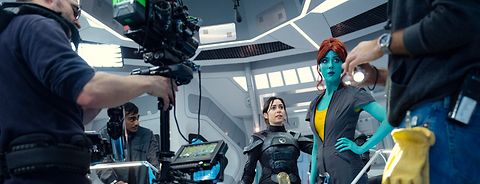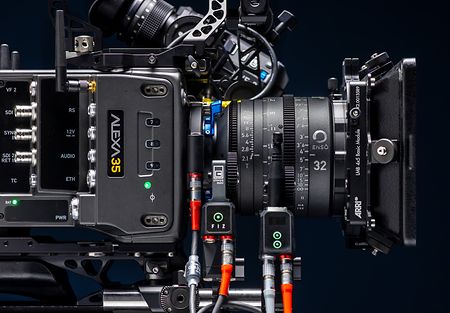Season four of Netflix’s dystopian anthology series “Black Mirror” kicked off in 2017 with the episode “USS Callister,” in which employees at a VR gaming company find themselves digitally cloned and trapped inside a virtual world created by a disgruntled colleague obsessed with a vintage sci-fi TV series. Winning huge audience approval and four Emmy Awards from seven nominations, the episode now has a sequel in season seven that re-teams many of the original cast and crew. Cinematographer Stephan Pehrsson BSC caught up with ARRI to discuss his creative choices and use of the ALEXA 35 camera on “USS Callister: Into Infinity.” Cinematographer Stephan Pehrsson BSC on the USS Callister spaceship set.
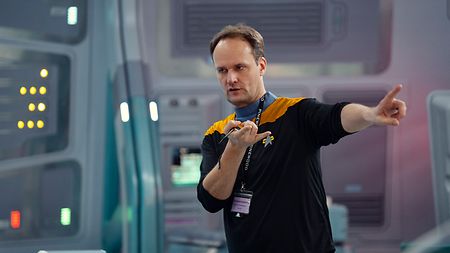
What were the challenges of returning to the USS Callister universe?
Well, none of the original sets had survived so they had to be rebuilt, but it meant we could learn from our experiences first time around. On the 2017 episode we had an amazing designer who came up with our spaceship and his approach was to specify where all the lights would go, cut holes in the set, and let us decide what fixtures and filtration and colors to use in those cut-out holes. Our first thought was LED battens, but we realized we needed 900 of them and that would have cost three times the lighting budget, so we had to find other solutions. For the sequel episode, LED technology had moved on and we had more freedom in our choices. Director Toby Haynes (left) in front of the viewport LED screen.
VFX technology had moved on as well, and for the second episode we had a new VFX team. They suggested that instead of having a big greenscreen outside the viewport of the spaceship command deck, we should have an LED screen that actually showed a view of space. By capturing that view in-camera, we had all of our reflections intact, because the starfield reflects on many of the surfaces on set. And for moments where they jumped into hyperspace, we could crank up the exposure on the LED screen and use that to light the actors, which was really useful.
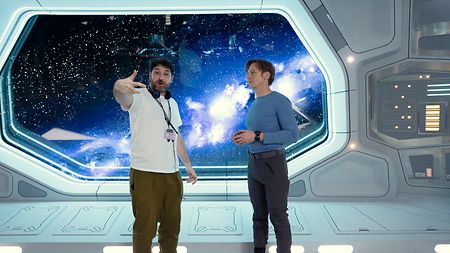
The new episode has a variety of different worlds – how did you decide what they should look like and how you would shoot them?
When Charlie Brooker writes the script he’ll just write “alien planet” and it could be anything, so it’s up to us. We had four alien planets in the script and we came up with new ideas for each – things like a jungle planet, an ice planet, a desert planet. Only the ice planet was in a studio because we would have needed two full nights on location to shoot it, so the studio was cheaper. We put in all these big rocks, with snowy atmosphere and a white cyc wall around the set, and did it in a controlled space. For the other three planets we wanted to find locations that would look like a video game but also give us an action movie feel. Two ALEXA 35 cameras shooting a scene on location at the old Welsh copper mine.
For the jungle planet we went to Black Park in Buckinghamshire because it had some amazing redwood trees and we dressed the jungle set around those. Then for the desert planet we found an old copper mine in Wales that was like a quarry and the walls had this amazing texture, with yellow sand but also blue and red lines of copper that made it look really colorful and alien. We were restricted to UK locations but we made it work; we had enough variety for it to feel interesting and exciting.
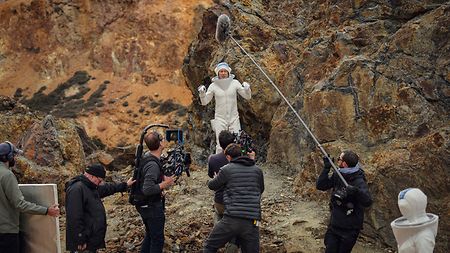
What made you choose ALEXA 35 for the sequel, and had you worked with it before?
Yes, I'd used the ALEXA 35 on the previous three or four jobs leading up to “USS Callister: Into Infinity” and I was really happy with it. The first time I used it was in Canada, filming snow outside in bright sunlight or inside a house looking out at snow with sun on it, and the camera held the bright contrast outside as well as inside, so the range was just incredible. In darker situations where I needed to push the ASA rating, I never had any problems with noise. The image holds up so well in the dark and you can pull so much detail out; the ALEXA 35 was great for that. A lot of people have been using large format, which to some extent limits your choice of lenses, but I was very happy to go back to a Super 35, 4:3 sensor and combine it with classic anamorphic lenses.
Which anamorphics did you choose, and why?
I was inspired by the adventure movie look associated with “Indiana Jones,” “Star Wars,” and the JJ Abrams “Star Trek” films. They have that beautiful anamorphic flare and the blue line you get sometimes, so to go in that direction I chose Panavision T-Series lenses. They worked brilliantly with the ALEXA 35 and that combination felt like the right choice for this project. The only time we varied the T-series look was when we see Jesse Plemons’s character in the garage of his house, for a scene set in the past in the real world and also a scene with his digital clone in the center of the VR game. We wanted a softer look so we used some Pro-Mist filtration to give it a slightly weird, nostalgic feeling. Panavision T-Series lenses were used on the ALEXA 35 to evoke a vintage anamorphic feel.
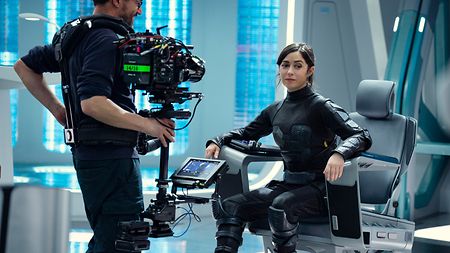
What was your approach to color on set and in the grade, and how much were you trying to replicate the look of the original episode?
We had an on-set DIT called James Shovlar who did a brilliant job. We gave him some basic ideas like pushing the snow planet a bit more towards white, or giving the jungle planet a teal and orange feel. Everything had its own look and we pushed it as much as we could on set, so when they sat in the edit they had all those looks lined up. Our workflow meant that these looks stayed all the way through to grading, so there was never a big surprise for the producers. We could stick pretty much to what we had done when we were on set. Hundreds of LED lights were built into the USS Callister command deck set.
In the final grade I started out by pushing to get as close as I could to the look of the original episode. For the real-world office scenes we’d had quite a drab, green-gray look that contrasted with the more vibrant and colorful world of the game. But for this second episode we had more scenes in the real world, including a long opening sequence, and the office set had more color and LED lighting built into it, so it made sense to move away from the drab gray towards a slightly more colorful feel.
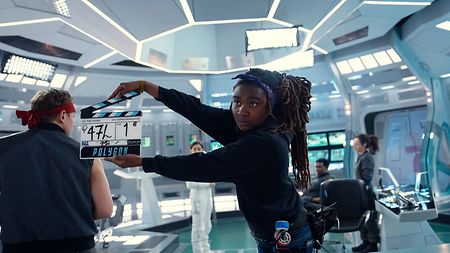
Looking back, how was your overall experience of reuniting with a lot of the same cast and crew seven years on from the original episode?
It felt like getting the old band back together. We had such a nice experience the first time around, and the wrap party was legendary! We just had fun every day, so it was great to get everybody back together. On the first day of filming on the spaceship set there was a mood of “Wow, okay, we’re here, we made it,” because it took years of planning. Everybody was so happy to be back; Jesse and the other actors couldn’t wait to get started and we knew we had to keep it a secret, but there was a lot of joy all around.
